









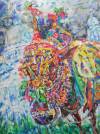
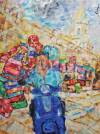
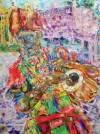
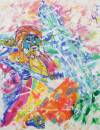
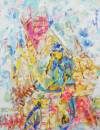
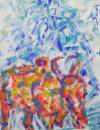
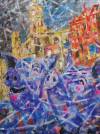
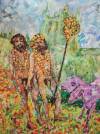

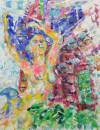
Ville Enigmatique
“Here Sen narrates the historical, cultural and sociological contamination between colonial powers and India, and how Bengali life continues over this backdrop.
The interaction between human profiles and architecture nourished with vibrant colours opens a lively dialogue between the past and present. Through his art Sen also stimulates an analysis on the history and identity of India since its Independence.
Hence, we must approach these works both in terms of chromatic language and content. References to British, French and Armenian presence in India are very clear, just look at BaulChandannagar. Only river Ganges divides the French architectural structures in Chandannagar from the small and poor village where Sen grew up in on the opposite side of the Ganges.
This town has played a key role in igniting Sen’s love for France. Additional backdrops he uses in his paintings showing life in Bengal today include Victoria Memorial, Saint Paul’s Cathedral, the Metropolitan building and Arminian Church. All the aspects help us understand the relationship in his art between Indian désordre and his European source of inspiration.”
Alberto Moioli, Member AICA. Editorial Director, Enciclopediad’ArteItaliana, Art Advisor Art Affinity


